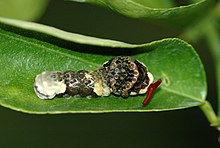Defences
Defences
Butterflies protect themselves from predators by a variety of means.
Chemical defences are widespread and are mostly based on chemicals of plant origin. In many cases the plants themselves evolved these toxic substances as protection against herbivores. Butterflies have evolved mechanisms to sequester these plant toxins and use them instead in their own defence.[79] These defence mechanisms are effective only if they are well advertised; this has led to the evolution of bright colours in unpalatable butterflies (aposematism). This signal is commonly mimicked by other butterflies, usually only females. A Batesian mimic imitates another species to enjoy the protection of that species' aposematism.[80] The common Mormon of India has female morphs which imitate the unpalatable red-bodied swallowtails, the common rose and the crimson rose.[81] Müllerian mimicry occurs when aposematic species evolve to resemble each other, presumably to reduce predator sampling rates; Heliconius butterflies from the Americas are a good example.[80]
Camouflage is found in many butterflies. Some like the oakleaf butterfly and autumn leaf are remarkable imitations of leaves.[82] As caterpillars, many defend themselves by freezing and appearing like sticks or branches.[83] Others have deimatic behaviours, such as rearing up and waving their front ends which are marked with eyespots as if they were snakes.[84] Some papilionid caterpillars such as the giant swallowtail (Papilio cresphontes) resemble bird droppings so as to be passed over by predators.[85] Some caterpillars have hairs and bristly structures that provide protection while others are gregarious and form dense aggregations.[80] Some species are myrmecophiles, forming mutualistic associations with ants and gaining their protection.[86] Behavioural defences include perching and angling the wings to reduce shadow and avoid being conspicuous. Some female Nymphalid butterflies guard their eggs from parasitoidal wasps.[87]
The Lycaenidae have a false head consisting of eyespots and small tails (false antennae) to deflect attack from the more vital head region. These may also cause ambush predators such as spiders to approach from the wrong end, enabling the butterflies to detect attacks promptly.[88][89] Many butterflies have eyespots on the wings; these too may deflect attacks, or may serve to attract mates.[53][90]
Auditory defences can also be used, which in the case of the grizzled skipper refers to vibrations generated by the butterfly upon expanding its wings in an attempt to communicate with ant predators.[91]
Many tropical butterflies have seasonal forms for dry and wet seasons.[92][93] These are switched by the hormone ecdysone.[94] The dry-season forms are usually more cryptic, perhaps offering better camouflage when vegetation is scarce. Dark colours in wet-season forms may help to absorb solar radiation.[95][96][90]
Butterflies without defences such as toxins or mimicry protect themselves through a flight that is more bumpy and unpredictable than in other species. It is assumed this behavior makes it more difficult for predators to catch them, and is caused by the turbulence created by the small whirlpools formed by the wings during flight.[97]


Comments
Post a Comment